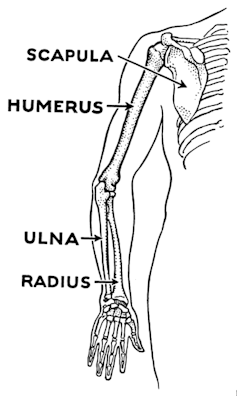Is the Humerus the Funny Bone
Put a finger on the point of your elbow.
Feel inwards from there about half and inch or slightly more until you find another bony outcrop.
Got it? Good.
Tap with your finger in the valley between those landmarks as hard as you like.
If you enjoyed that sensation you're very much in the minority! You just found your funny bone.
The funny bone is one of my favourite bits of medical slang because whoever came up with it had a savage sense of irony. According to the Oxford English Dictionary, the first recorded use of the term occurred in a dreadful doggerel poem published in 1842 called Bloudie Jack of Shrewsberrie.
In the poem, the unfortunate Jack (a serial killer and general ne'er-do-well, as far as I can work out) is caught by a mob and torn apart "until the 'funny bones' crack, as if you were stretched on a rack".
The usage here seems to point directly to the term as a straight out pun. The main bone of the upper arm is called the humerus (humerus, funny bone, get it?). It must have been a bit of regional slang to have cropped up in such a lowbrow source.

The point of the elbow (the olecranon) is in fact part of the ulna, a bone of the forearm. The bony outcrop you felt earlier on the inside of the elbow is the medial epicondyle (inner bony protrusion) of the humerus.
The painfully sensitive part between the olecranon and the medial epicondyle is the site of the ulnar nerve. On its long journey from the base of the neck to the tips of the little finger and ring finger, the ulnar nerve snakes around the inner aspect of the elbow joint at this point, lying close to the skin behind the medial epicondyle.
If you tap it hard enough to produce a tingling or zapping sensation, that's called a Tinel's test. A hypersensitive or entrapped nerve will cause the tingling at low levels of stimulation (Tinel's sign). Whacking it really hard will cause a mild nerve injury (neurapraxia) which may take minutes, hours or even days to come good. This unpleasant nerve sensation is what most people refer to as "hitting the funny bone".
Even though the original – and rather laborious pun – underlying the whole "funny bone" gag has been long since lost, as it now refers to a nerve experience rather than a bone, the phrase lives on. And it's joined by another couple of other nerve sensations in the upper limb which go by equally colourful names.
The classic schoolboy dead arm refers to the inability to lift your arm following a well-placed punch to an unsuspecting victim's deltoid muscle. This is because the muscle pain causes a direct inhibition of motor function courtesy of the monosynaptic reflex arc. When the muscle pain reduces, the motor function is restored, often without any residual soreness if the blow has been expertly delivered.
A more serious type of dead arm is also called a "stinger" and tends to occur in professional contact sports, when the head is forced away from the shoulder such as in a collision. This type of dead arm is caused by damage to the brachial plexus, which is the bundle of nerves at the base of the neck that provide sensation and movement to the whole upper limb. These can be severe, and potentially career-ending injuries.

A Saturday night palsy occurs when the radial nerve under the armpit is compressed or stretched, usually by falling asleep with your arm left hanging. As for the name, it's probably more likely to happen after a heavy night on the booze.
So whether the problem is from your funny bone, a dead arm, stinger or Saturday night palsy, the common factor underlying them is the risky path that delicate nerves have to take to bring sensation and movement to your hand and arm.
Source: https://theconversation.com/explainer-what-is-the-funny-bone-12149
0 Response to "Is the Humerus the Funny Bone"
Post a Comment